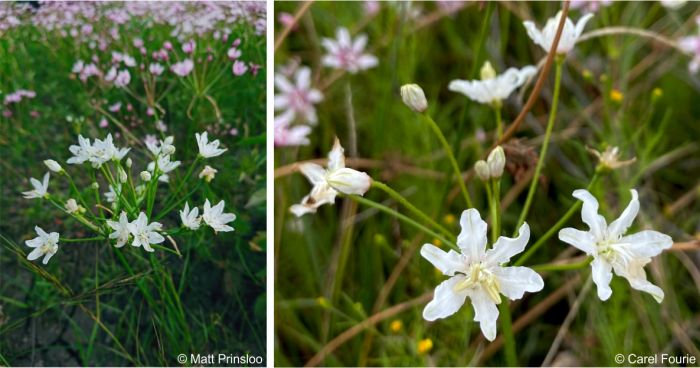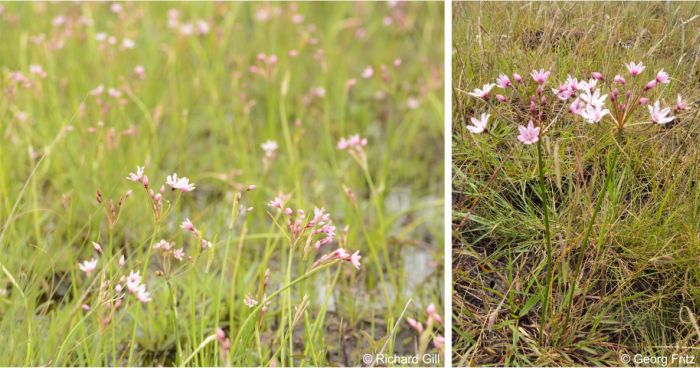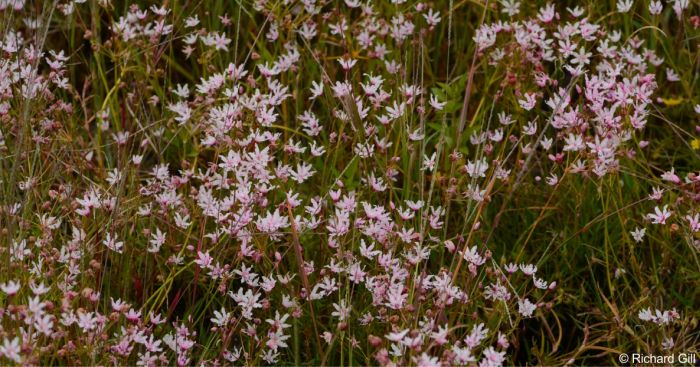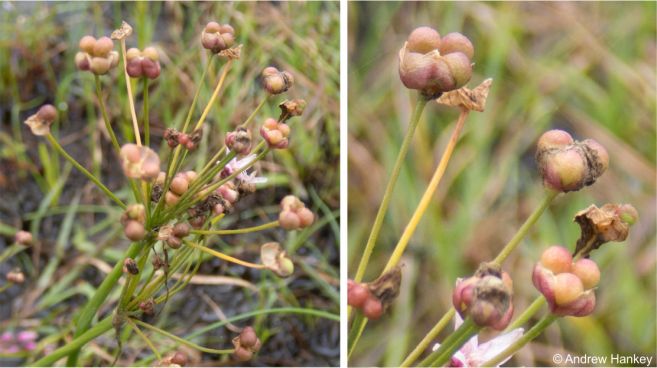Nerine gracilis
Nerine gracilis R.A.Dyer
Family: Amaryllidaceae
Common names: delicate nerine
Introduction
Nerine gracilis is a dwarf, indigenous South African bulb, that can only be found in a few localities in rocky and damp Highveld Grassland. It has thread-like leaves and umbels of pink, cup-shaped flowers in late summer, and makes a rewarding ornamental plant.

Description
Description
Nerine gracilis is a fast-growing, deciduous, summer flowering, perennial bulb 160-360 mm tall. During winter the plant becomes dormant and loses its leaves, but come the growing season it grows back its leaves. The bulb is globose, 11-155 mm in diameter with a long neck, 20-70 mm long. It produces about 2-4 linear leaves, 150-310 mm long and 1.0-1.5 mm wide, erect or suberect, with smooth, weakly channeled upper surfaces. The leaves appear together with flowers. It has erect, leafless stems, each bearing a terminal umbel of cup-shaped flowers in late summer to autumn. Flowers are pale pink to dark pinkish rose or even pale lavender, as well as white, varying from one colony to another. The stamens are short and spreading, bending downward (declinate), with each filament having a well-developed, linear, 2 or 3 lobed appendage at the base that grows up to 2 mm long. The peduncle and pedicel are covered with short, widely separated white hairs, and the pedicels elongating strongly during the fruiting stage, sometimes to up to 58 mm long. It flowers from summer to autumn (February to April) with a peak in March. The bulbs which grow in the wettest habitat flower first. After flowering, it produces light green seeds that are about 4-5 mm wide. The seeding period is in late summer and lasts from mid-February until about the middle of March. Germination of Nerine gracilis is good in a habitat with high soil saturation and plants seed themselves very freely when the soil is saturated and damp.

Conservation Status
Status
According to the Red List of South African Plants, the conservation status for this Nerine is Vulnerable (VU). Nerine gracilis is threatened by ongoing degradation and loss of habitat due to overgrazing, crop cultivation and urban development.
Distribution and habitat
Distribution description
Nerine gracilis is known from northern, south-central and southern Mpumalanga, eastern Gauteng and northern Free State with an outlying population west of Wolmaransstad in the southern part of North West Province. It is still common near Devon and Heidelberg in southern Gauteng. This species is a gregarious species, usually occurring in dense, large colonies, sometimes numbering thousands of plants. It occurs in damp grassland in heavy clay, growing in seasonally wet depressions in shallow soil over dolerite rock sheets. Nerine gracilis is frost tolerant, requires ample water, cool temperatures, and clay soil with high saturation.

Derivation of name and historical aspects
History
In February 1936, I.B Pole-Evans, a botanist and mycologist, became the first person to collect a specimen of Nerine gracilis, between Bethal and Ermelo in Mpumalanga. In 1937 the species was described by R.A Dyer in volume 17 of the Flowering Plants of South Africa, illustrated by Cythna Letty. The species name gracilis refers to the slender and delicate habit of this species. Dyer published a line drawing and condensed description in Herbertia volume 15 in 1948. Duncan published a description in his 2016 book The Amaryllidaceae of southern Africa with an accompanying plate by Barbara Jeppe that was painted from a specimen found along the northern shore of the Vaal Dam in southern Mpumalanga.
The genus Nerine was named by William Herbert (1778-1847) in 1820. It is named after a guardian sea nymph, Nerine, sent by the Roman goddess Venus to rescue Vasco Da Gama’s armada en route to India. This genus was named Imhofia in 1755 by a different botanist but that name was not adopted. The most beautiful, and famous member of the genus is Nerine sarniensis, widely known as the Guernsey lily. This name came into existence because this plant flourishes on Guernsey, an island between France and Great Britain, despite the fact that it is indigenous to the southern tip of Africa. It is believed to have arrived on Guernsey when a ship carrying boxes of bulbs of Nerine sarniensis consigned for Holland was shipwrecked on Guernsey and the bulbs washed ashore, and became established on the island. Although this story is not true, it is the reason why Herbert chose the name Nerine for the genus, referring to this fictitious shipwreck and rescue of the bulbs. Nerine belongs in the family Amaryllidaceae. Southern Africa has 18 genera, and 210 endemic Amaryllidaceae species. Namaqualand and the Cape Region together have 111 species and 77% of these are found nowhere else in the world. Amaryllidaceae occupy many different habitats: seasonally dry places, ephemeral pools, the understory of rainforests, and rivers.

Ecology
Ecology
The major habitat of Nerine gracilis is grassland. It is usually pollinated by flying insects that have a short proboscis, which includes honeybees, butterflies, wasps and solitary bees. Nerines should be regarded as poisonous to animals such as pets.

Uses
Use
Nerines are well-known garden ornamentals and long-lasting cut flowers. Nerine gracilis is not often seen in cultivation but it deserves a place and it makes a good container plant or garden plant, mass planted for best effect. It is probably very resistant to cold as it grows in areas with lowest winter temperatures in South Africa and is suitable for Highveld gardens.

Growing Nerine gracilis
Grow
Nerine gracilis is best propagated through seeds. Seeds are fleshy, they take 3-4 weeks to mature and must be sown immediately when ripe, when they detach easily from the capsules. A well-drained soil mixture of 70% potting mix and 30% sand, or equal parts of river sand and silica sand with finely sifted compost added is recommended to grow nerines from seeds. Use a deep seed tray, sprinkle the seeds evenly over the surface and cover them with a thin layer of the same soil mixture and water well with a fine rose. The seeds root themselves quickly and the small bulbs take 2-3 weeks to develop but they are very vulnerable to dry weather at this time so avoid dry conditions during this stage. The young plants should be left in the seed tray for at least 2 years and potted up at the beginning of summer.

Nerine gracilis can also be propagated by removing offsets from the mature bulb in late spring, just before or at the beginning of the growing season. The offsets are ready to be removed if they are easily separated from the mature bulb and must not be forcibly broken off. The separated offsets must be replanted immediately.
Because this is a dwarf species, it is best grown in containers, planted close together and massed for best effect. Grow Nerine gracilis in free-draining sandy soil with the addition of a little fine-sifted compost. Place them in full sun. During the summer season, give regular heavy watering every 7 to 10 days. In temperate climates or in the greenouse plants will remain evergreen but in cold climates it should be allowed to go dormant during winter and the bulbs should be left dry. It is a fast growing plant which thrives under controlled climate conditions or in a greenhouse. They are best planted in mixed flower beds, and are suitable for containers. When planting in plastic pots, it is recommended to use the 20 cm size. Plant the bulbs with the top of the neck resting at the soil level or just above it. It flowers in late summer to early autumn.
Nerine gracilis plants are susceptible to Mealy Bug infestation and Narcissus Bulb Flies. They should be treated frequently, especially in the beginning of the growing season, with systemic insecticide such as Imidacloprid. They are also vulnerable to attack from Amaryllis Caterpillar that eats all parts of the plant and the seeds. Nerines are poisonous to animals (pets) when eaten, and need to planted in areas where pets cannot access them.
References
- Craib, C. 2002. Nerine gracilis: A rare nerine from Mpumalanga. Veld & Flora 88(3):105-107.
- Duncan, G.D. 2016. The Amaryllidaceae of southern Africa. Umdaus Press, Pretoria.
- Duncan, G.D. 2002. Grow nerines: Kirstenbosch Gardening Series. National Botanical Institute, Cape Town.
- Duncan, G.D. 2002. Nerine sarniensis (L.) Herb. (Amaryllidaceae). PlantZAfrica. Online. http://pza.sanbi.org/nerine-sarniensis.
- Dyer, R.A. 1937. Nerine gracilis. Flowering Plants of Africa 17:t. 679.
- Fourie, C. 2023. Observation of Nerine gracilis. iNaturalist. Online. https://www.inaturalist.org/observations/149310922.
- Fritz, G. 2010. Observation of Nerine gracilis. iNaturalist. Online. https://www.inaturalist.org/observations/10846756.
- Gill, R. 2023. Observations of Nerine gracilis. iNaturalist. Online. https://www.inaturalist.org/observations/150397929, https://www.inaturalist.org/observations/150397926, https://www.inaturalist.org/observations/149311159.
- Hankey, A. 2023. Observations of Nerine gracilis. iNaturalist. Online. https://www.inaturalist.org/observations/149477380, https://www.inaturalist.org/observations/149477401, https://www.inaturalist.org/observations/149477378.
- Pfab, M.F. & Victor, J.E. 2002. Threatened plants of Gauteng, South Africa. South African Journal of Botany 68:370-375.
- Prinsloo, M. 2021. Observation of Nerine gracilis. iNaturalist. Online. https://www.inaturalist.org/observations/70076033.
- Raimondo, D. 2013. Nerine gracilis R.A.Dyer. National Assessment: Red List of South African Plants version 2020.1. Accessed on 2023/11/27.
Credits
Ntsako Colins Chauke
Walter Sisulu National Botanical Garden
December 2023
Acknowledgements: the author thanks Dineo Dibakwane and Alice Notten for assisting with the text, and Andrew Hankey, Richard Gill, Carel Fourie, Georg Fritz and Matt Prinsloo for uploading their pictures on iNaturalist and allowing us to use the images.
Plant Attributes:
Plant Type: Bulb
SA Distribution: Free State, Gauteng, Mpumalanga, North West
Soil type: Sandy, Clay, Loam
Flowering season: Late Summer, Autumn
PH: Acid, Neutral
Flower colour: White, Pink
Aspect: Full Sun
Gardening skill: Easy
Special Features:
Horticultural zones









Rate this article
Article well written and informative
Rate this plant
Is this an interesting plant?
Login to add your Comment
Back to topNot registered yet? Click here to register.